Barakee is a national park in New South Wales, Australia, 257 km north of Sydney. It is connected to Barakee State Conservation Area.
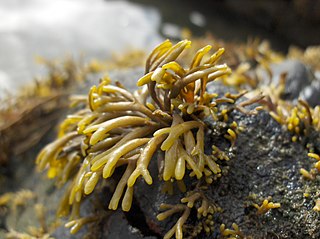
Pelvetia canaliculata, the channelled wrack, is a very common brown alga (Phaeophyceae) found on the rocks of the upper shores of Europe. It is the only species remaining in the monotypic genus Pelvetia. In 1999, the other members of this genus were reclassified as Silvetia due to differences of oogonium structure and of nucleic acid sequences of the rDNA.

Pomacea canaliculata, commonly known as the golden apple snail or the channeled apple snail, is a species of large freshwater snail with gills and an operculum, an aquatic gastropod mollusc in the family Ampullariidae, the apple snails. South American in origin, this species is considered to be in the top 100 of the "World's Worst Invasive Alien Species". It is also ranked as the 40th worst alien species in Europe and the worst alien species of gastropod in Europe.
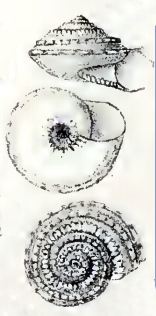
Lirularia canaliculata is a species of sea snail, a marine gastropod mollusk in the family Trochidae.
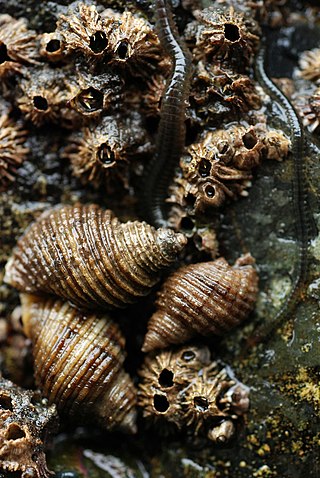
Nucella canaliculata, commonly known as the channeled dog winkle or the channeled purple, is a species of sea snail, a marine gastropod mollusk in the family Muricidae, the murex snails or rock snails. The shell grows to a maximum length of about 4 cm (1.6 in). This species is distributed in the northeastern Pacific Ocean from the Aleutian Islands to California.

Amoria canaliculata, common name the channeled volute, is a species of sea snail, a marine gastropod mollusc in the family Volutidae, the volutes.
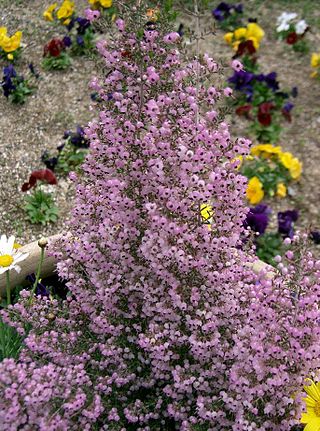
Erica canaliculata, the channelled heath or hairy grey heather, is a South African species of flowering plant in the family Ericaceae.

Eucalyptus canaliculata, commonly known as grey gum, is a tree endemic to a small area in New South Wales in eastern Australia. It has smooth, mostly grey bark, lance-shaped to curved adult leaves, flower buds in groups of seven, white flowers and conical or hemispherical fruit.

Eucerceris provancheri is a species of wasp in the family Philanthidae. It is found in Central America and North America.
Eucerceris is a genus of wasps in the family Philanthidae. There are more than 40 described species in Eucerceris.
Eucerceris arenaria is a species of wasp in the family Philanthidae. It is found in North America.
Eucerceris superba is a species of wasp in the family Philanthidae. It is found in North America.
Eucerceris flavocincta is a species of wasp in the family Philanthidae. It is found in North America.
Ampulex canaliculata is a species of cockroach wasp in the family Ampulicidae.

Ginataang kuhol is a Filipino snail stew made from apple snails in coconut milk with leafy vegetables, onion, garlic, ginger, siling haba chilis, bagoong alamang, and salt and pepper. Labuyo chilis are also commonly added for a spicier version. The leafy vegetables can include water spinach, moringa leaves, and chili pepper leaves, among others.

Protea canaliculata, also known as the groove-leaf sugarbush, is a species of flowering shrub of the genus Protea, which is endemic to the Cape Provinces of South Africa.
Perivitellins are egg proteins found in the perivitelline fluid of many gastropods. They are multifunctional complexes providing the developing embryo with nutrition, protection from the environment, and defense against predators.
The following is a list of invasive alien species (IAS) in the Philippines. These species are regarded to have a negative effect on the local ecosystem and the economy, although not all species introduced from outside the archipelago are considered as "invasive".

Pultenaea canaliculata, commonly known as coast bush-pea, is a species of flowering plant in the family Fabaceae and is endemic to coastal areas of southern continental Australia. It is a rigid, spreading shrub with hairy, cylindrical leaves, and yellow and crimson flowers.
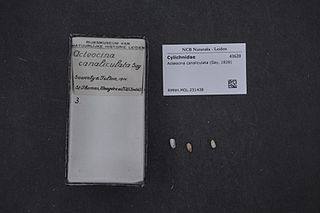
Acteocina canaliculata is a species of gastropods belonging to the family Tornatinidae.











